The AMD Threadripper 2990WX 32-Core and 2950X 16-Core Review
by Dr. Ian Cutress on August 13, 2018 9:00 AM ESTHEDT Benchmarks: Web and Legacy Tests
While more the focus of low-end and small form factor systems, web-based benchmarks are notoriously difficult to standardize. Modern web browsers are frequently updated, with no recourse to disable those updates, and as such there is difficulty in keeping a common platform. The fast paced nature of browser development means that version numbers (and performance) can change from week to week. Despite this, web tests are often a good measure of user experience: a lot of what most office work is today revolves around web applications, particularly email and office apps, but also interfaces and development environments. Our web tests include some of the industry standard tests, as well as a few popular but older tests.
We have also included our legacy benchmarks in this section, representing a stack of older code for popular benchmarks.
WebXPRT 3: Modern Real-World Web Tasks, including AI
The company behind the XPRT test suites, Principled Technologies, has recently released the latest web-test, and rather than attach a year to the name have just called it ‘3’. This latest test (as we started the suite) has built upon and developed the ethos of previous tests: user interaction, office compute, graph generation, list sorting, HTML5, image manipulation, and even goes as far as some AI testing.
For our benchmark, we run the standard test which goes through the benchmark list seven times and provides a final result. We run this standard test four times, and take an average.
Users can access the WebXPRT test at http://principledtechnologies.com/benchmarkxprt/webxprt/
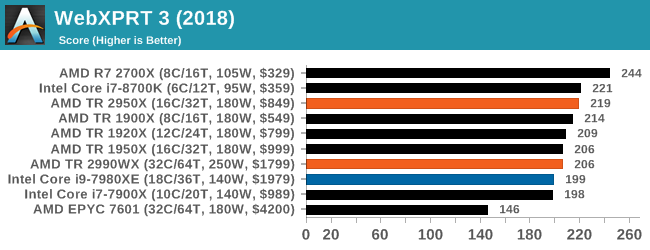
WebXPRT 2015: HTML5 and Javascript Web UX Testing
The older version of WebXPRT is the 2015 edition, which focuses on a slightly different set of web technologies and frameworks that are in use today. This is still a relevant test, especially for users interacting with not-the-latest web applications in the market, of which there are a lot. Web framework development is often very quick but with high turnover, meaning that frameworks are quickly developed, built-upon, used, and then developers move on to the next, and adjusting an application to a new framework is a difficult arduious task, especially with rapid development cycles. This leaves a lot of applications as ‘fixed-in-time’, and relevant to user experience for many years.
Similar to WebXPRT3, the main benchmark is a sectional run repeated seven times, with a final score. We repeat the whole thing four times, and average those final scores.
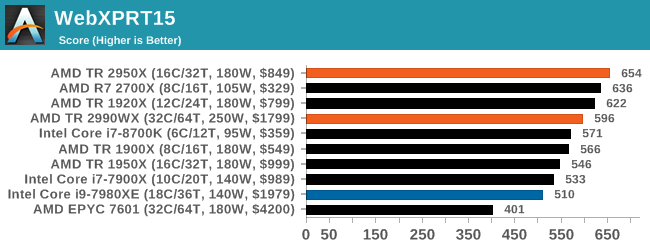
Speedometer 2: Javascript Frameworks
Our newest web test is Speedometer 2, which is a accrued test over a series of javascript frameworks to do three simple things: built a list, enable each item in the list, and remove the list. All the frameworks implement the same visual cues, but obviously apply them from different coding angles.
Our test goes through the list of frameworks, and produces a final score indicative of ‘rpm’, one of the benchmarks internal metrics. We report this final score.
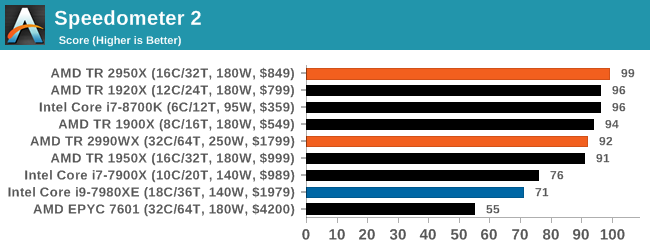
Google Octane 2.0: Core Web Compute
A popular web test for several years, but now no longer being updated, is Octane, developed by Google. Version 2.0 of the test performs the best part of two-dozen compute related tasks, such as regular expressions, cryptography, ray tracing, emulation, and Navier-Stokes physics calculations.
The test gives each sub-test a score and produces a geometric mean of the set as a final result. We run the full benchmark four times, and average the final results.

Mozilla Kraken 1.1: Core Web Compute
Even older than Octane is Kraken, this time developed by Mozilla. This is an older test that does similar computational mechanics, such as audio processing or image filtering. Kraken seems to produce a highly variable result depending on the browser version, as it is a test that is keenly optimized for.
The main benchmark runs through each of the sub-tests ten times and produces an average time to completion for each loop, given in milliseconds. We run the full benchmark four times and take an average of the time taken.
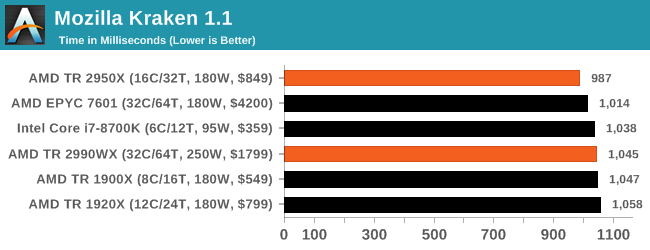
3DPM v1: Naïve Code Variant of 3DPM v2.1
The first legacy test in the suite is the first version of our 3DPM benchmark. This is the ultimate naïve version of the code, as if it was written by scientist with no knowledge of how computer hardware, compilers, or optimization works (which in fact, it was at the start). This represents a large body of scientific simulation out in the wild, where getting the answer is more important than it being fast (getting a result in 4 days is acceptable if it’s correct, rather than sending someone away for a year to learn to code and getting the result in 5 minutes).
In this version, the only real optimization was in the compiler flags (-O2, -fp:fast), compiling it in release mode, and enabling OpenMP in the main compute loops. The loops were not configured for function size, and one of the key slowdowns is false sharing in the cache. It also has long dependency chains based on the random number generation, which leads to relatively poor performance on specific compute microarchitectures.
3DPM v1 can be downloaded with our 3DPM v2 code here: 3DPMv2.1.rar (13.0 MB)

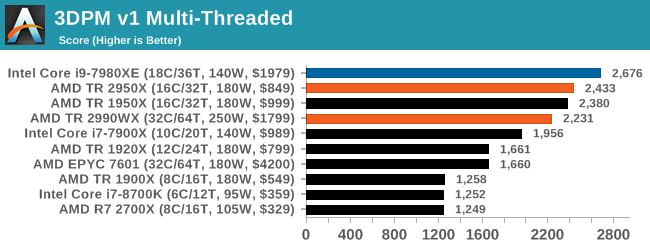
x264 HD 3.0: Older Transcode Test
This transcoding test is super old, and was used by Anand back in the day of Pentium 4 and Athlon II processors. Here a standardized 720p video is transcoded with a two-pass conversion, with the benchmark showing the frames-per-second of each pass. This benchmark is single-threaded, and between some micro-architectures we seem to actually hit an instructions-per-clock wall.
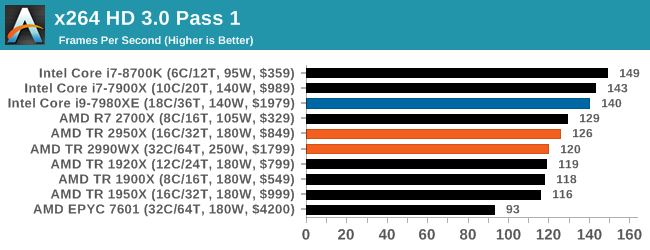
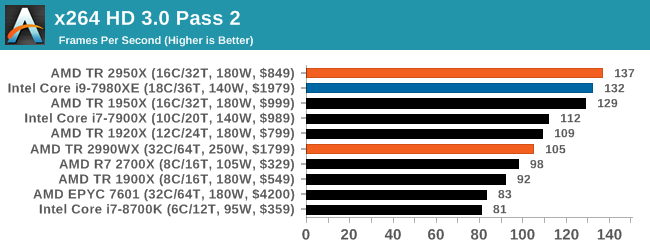










171 Comments
View All Comments
T1beriu - Monday, August 13, 2018 - link
> We confirmed this with AMD, but for the most part the scheduler will load up the cores that are directly attached to memory first, before using the other cores. [...]It seems that Tomshardware says the opposite:
>AMD continues working with Microsoft to route threads to the die with direct-attached memory first, and then spill remaining threads over to the compute dies. Unfortunately, the scheduler currently treats all dies as equal, operating in Round Robin mode. [...] According to AMD, Microsoft has not committed to a timeline for updating its scheduler.
Ian Cutress - Monday, August 13, 2018 - link
Yeah, Paul and I were discussing this. It is a round robin mode, but it's weighted based on available resources, thermal performance, proximity of busy threads, etc.JoeyJoJo123 - Monday, August 13, 2018 - link
Maybe just user error, but all the article pages between Test Setup and Comparison Results to Going up Against Epyc, just have the text "Still writing...". I'm unsure if the article is actually still being written and was supposed to be published in this partial manner or if possible something was lost between writing and upload.In any case, kind of crazy how the infinity fabric is consuming so much power. The cores look super-efficient, but if the uncore can get efficiency improvements, that can help the Zen architecture stay even more efficient under load. Intel's uncore consumes a fraction of the wattage, but doesn't scale as well for multiple threads.
Ian Cutress - Monday, August 13, 2018 - link
Still being written. See my comment at the top. Unfortunately travel back and forth from UK to SF bit me over the weekend and I lost a couple of days testing, along with having to take a full benchmark set up with me to SF to test in the hotel room.JoeyJoJo123 - Monday, August 13, 2018 - link
I understand, take your rest. You don't need to reply to me, I actually saw the reason after I posted.compilerdev2 - Monday, August 13, 2018 - link
Hi Ian,I have some questions about the Chromium compilation benchmark, since I was hoping to get the 2990WX for compiling large C++ apps. What version of Chromium is used? Is the compiler being used Clang-CL or Visual C++? Is the build in debug or release (optimized) mode? If it's release mode with Visual C++, does it use LTCG? (link-time code generation, the equivalent of LTO of gcc/clang). For example, if the build is Visual C++ LTCG, the entire code optimization, code generation and linking is by default limited to 4 threads. Thanks!
Ian Cutress - Monday, August 13, 2018 - link
It's the standard Windows walkthrough available online. So we use a build of Chrome 62 (it was relevant when we pulled), VC++, build in release. It's done in the command line via ninja, and yes it does use LTCG.Destructions are here. They might be updated a little from when I wrote the benchmark. Out test is automated to keep consistency.
https://chromium.googlesource.com/chromium/src/+/m...
compilerdev2 - Monday, August 13, 2018 - link
With LTCG those strange results make sense - it's spending a lot of time on just 4 threads - actually majority of the time is on one thread for the Chromium case, it hits some current limitations of the VC++ compiler regarding CPU/memory usage that makes scaling worse for Chromium (but not for smaller programs or with non-LTCG builds). Increasing the number of threads from the default of 4 is possible, but will not help here. The frontend (parsing) work is well parallelized by Ninja, it's probably the reason why the Threadrippers do end up ahead of the faster single-core Intel CPUs. It would be interesting to see the benchmarks without LTCG, or even better, more compilation benchmarks, since these CPUs are really great for C/C++/Rust programmers.Nexus-7 - Monday, August 13, 2018 - link
Cool write-up on the uncore power usage! I especially enjoyed that part of the article.johnny_boy - Monday, August 13, 2018 - link
The Phoronix articles are more telling for the sort of workloads a 64 thread count would be used for.